
views
X
Expert Source
Susan StockerGreen Cleaning Expert
Expert Interview. 8 November 2020.
Cleaning Your Leather Couch
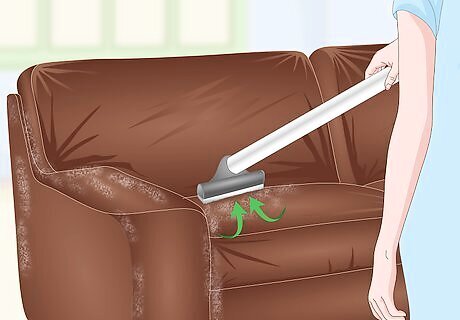
Vacuum the couch to remove any dust or debris. Attach a brush or bristle end to your vacuum cleaner and turn it on. Run the vacuum over the entire surface of your couch, getting in between any crevices and cracks around the cushions or armrests to make sure the couch is free of debris. If you don’t have a vacuum cleaner with a brush attachment, you can also use your vacuum cleaner normally to clean the couch. Make sure you don’t apply too much pressure, so as to avoid damaging or dirtying the leather further.

Make a cleaning solution of diluted white vinegar. While there are different leather cleaning solutions available for purchase, one of the easiest and most effective leather cleaners is diluted white vinegar. Combine equal parts of white vinegar and water in a bowl and stir to combine. Apple cider vinegar, or any vinegar without a particularly strong scent, will work as well. If you purchase a leather repair kit for other parts of the restoration process, it might come with a leather cleaner as well. This will work just as well, if not better, than your homemade solution.
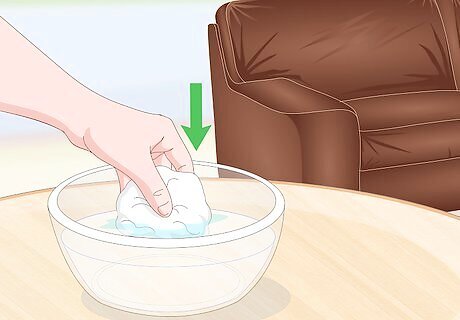
Dampen a microfiber cloth in your cleaning solution. A clean, dry microfiber cloth will be soft enough on the leather to avoid scratching it. Dip your microfiber cloth in the cleaning solution, wringing out the excess back into the bowl. The cloth should absorb a small amount of the cleaning solution, but shouldn’t be dripping. Microfiber cloths are great for cleaning all sorts of things, so are fantastic to have on hand. They should be available online, or from your local homeware store.
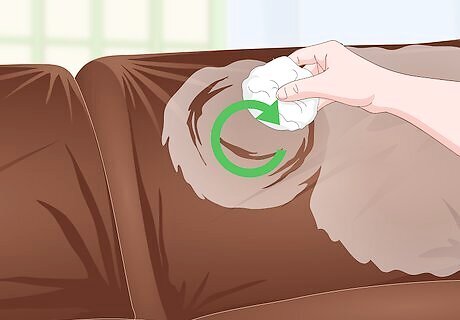
Wipe down the couch in small, circular motions. Start at one of the top corners of your leather couch and begin working across the surface. Use small, circular motions to clean the couch in different sections, dipping the microfiber cloth in the cleaning solution each time it becomes dry or dirty. Cleaning the leather in small, circular motions will help the cleaning solution get into the fibers of the leather, pulling out more dirt and grime without damaging it.
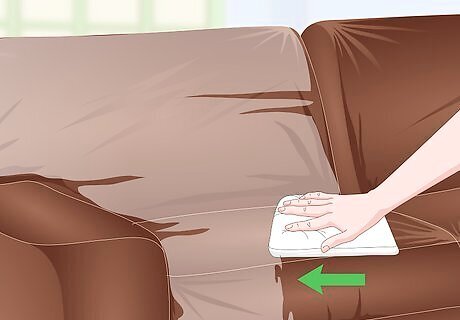
Dry the couch with a clean towel. Once you’ve cleaned the surface of the couch, use a clean and dry towel to dab away any noticeable or excess cleaning solution. Wipe down the couch all over to dry it off and prevent the moisture from seeping into the leather. Don’t leave the couch to air-dry, as this will usually leave marks or lines on your furniture. Dry it off with a towel as soon as you’ve finished cleaning it.
Getting Rid of Difficult Stains
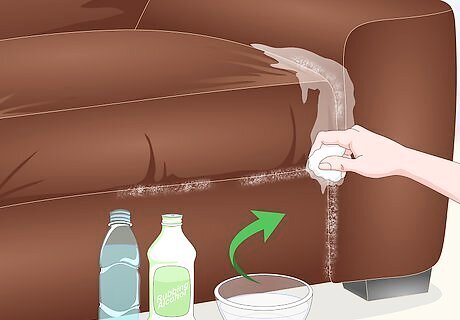
Clean mold and mildew with diluted rubbing alcohol. Mold and mildew can build up on leather if it stays too damp for too long. If you notice either on your leather couch, combine equal quantities of water and rubbing alcohol in a bowl. Use a microfiber cloth to clean the area with the diluted rubbing alcohol, working in small and circular motions. The rubbing alcohol will help kill the mold and wipe it away from your couch. Dip the cloth in the diluted rubbing alcohol again if it becomes dry or dirtied.
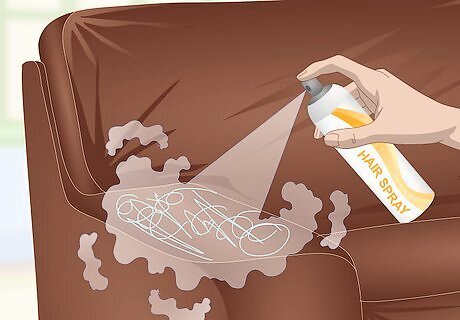
Remove pen marks with hairspray or eucalyptus oil. If you do a lot of writing or other work on your couch, a mark from a dropped pen is almost inevitable. Dip a cotton swab in eucalyptus oil and rub it over the mark left by a ballpoint pen to clean it away. For a permanent marker stain, try spraying it with aerosol hairspray before wiping away the excess. If you don’t have eucalyptus oil, you could also try using rubbing alcohol to get rid of ink stains. Test the cleaning solution you choose on a small area of your couch first.
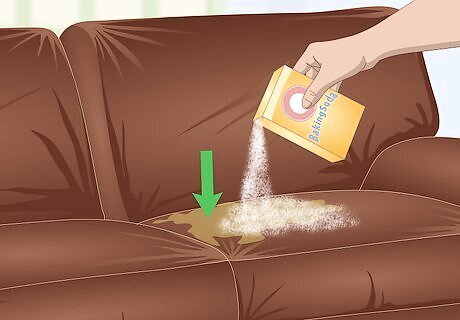
Use baking soda to fix greasy marks or stains. Greasy stains can ruin the look and feel of your leather couch. Try covering the affected, greasy area with a light sprinkling of baking soda. Leave it to sit for 3 to 4 hours before wiping it away with a clean cloth. The baking soda will help absorb the grease, so it can be wiped away more easily. If you notice a little grease left on your couch after cleaning it with baking soda, try and wipe it away with a clean, dry cloth. If that doesn’t work, use more baking soda and leave it to sit for longer before wiping it away.

Try lemon juice and cream of tartar to treat dark stains on light leather. If your leather couch is made of white or tan leather, dark stains may be more noticeable. Combine equal parts of lemon juice and cream of tartar in a bowl, stirring into a paste. Rub the paste onto the stain, leaving it to sit for 10 minutes before wiping it away with a damp cloth. The lemon juice and cream of tartar will help lift the stain out of the leather and help restore the lighter color. However, it should not be used on darker leather, as it will affect the color.
Patching up Holes and Tears
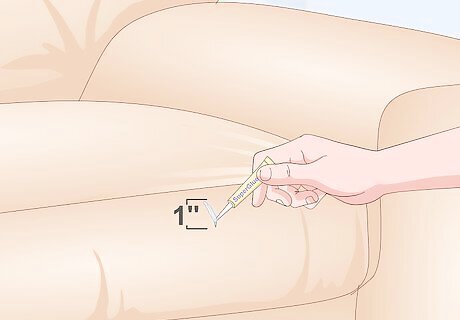
Fix tears smaller than 1 inch (2.5 cm) with superglue. If you notice a small tear in the leather of your couch, it may be able to be fixed easily with a little super glue. Use your fingers to press the tear together and line it with a thin coat of super glue. Hold the leather in place until the glue sets up and holds the tear together. If you want to disguise the tear further, apply a small amount of leather binder over the superglue once it has set. Rub this in with a paper towel or sponge until the tear is obscured. Alternately, you can sand down the area around the tear with fine grit sandpaper. Use 220 to 320-grit sandpaper over the tear while the glue dries. This will create leather dust that binds with the glue and hides the tear. You may need to refinish the worn leather after this.

Start with a rounded sub-patch for larger holes and tears. A sub-patch, made of leather, suede, or something similar, sits behind the tear to hold the material together. Leave an extra ⁄4 inch (6.4 mm) around each edge of the patch that can be glued to the inside of the couch. Use a pair of scissors to round the corners of the patch. Rounding the corners of the patch make it easier to get it into the right place without creating bumps in the fabric. If you don’t have any material to use as a sub-patch, purchase a leather repair kit online or from a leather specialty store. This will come with everything you need to repair a hole in your leather couch, including a few sub-patches.
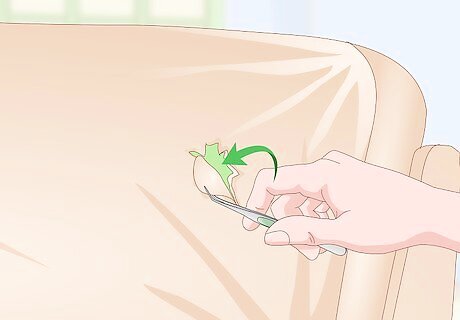
Use a pair of tweezers to position the patch behind the hole. Hold the sub-patch over the tear so that it is centered. Using a pair of tweezers, push one side of the patch into the tear so that it sits behind the leather of the couch. Work around the edge of the patch with the tweezers until it sits evenly behind the tear. Once you have the patch in the right position, run your hands over the area to feel for any bumps or grooves that may not be visible. Use the tweezers on the inside of the couch to flatten the patch and fix the bumps before moving on. If the tear is on the cushion of your couch, check to see if the cushion can be removed and if there is a zip that allows for access to the inside. If you can remove the cushion from the leather covering and turn the cover inside out, you’ll be able to flatten and apply the patch much more easily.
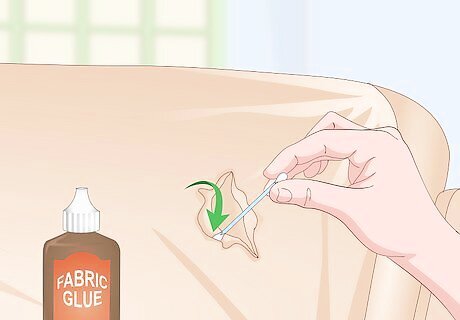
Glue the sub-patch to the leather and wipe away any excess. Apply a small dab of leather or fabric glue to the end of a toothpick or cotton swab. Avoiding the flaps around the tear, rub the glue between the sub-patch and the inside of the leather. Work around the entire patch, applying more glue as needed. Use a paper towel to wipe away any excess glue left on the visible leather on the couch.
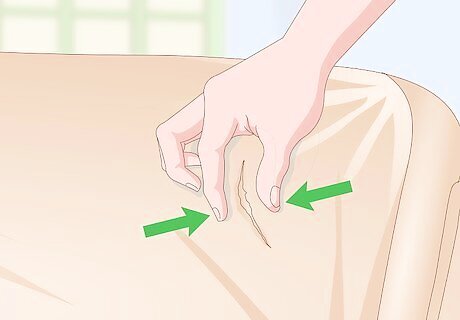
Seal the tear and weigh it down while the glue dries. Use your fingers to begin carefully pushing the 2 sides of the tear or hole back together. Once the area looks as even and homogenous as you can make it, place a piece of flat wood or a heavy book over the tear. This will weigh it down, keeping everything flat and together as the glue dries. If the tear or hole is uneven, there may be loose threads or misshapen edges that need to be lined up more carefully. Take your time to connect these properly, lining up the edges or overlapping loose threads to hide the tear as much as possible. Check the instructions on your leather glue for more information on how long it will take to dry. Most glues should dry quickly within 5 to 10 minutes.
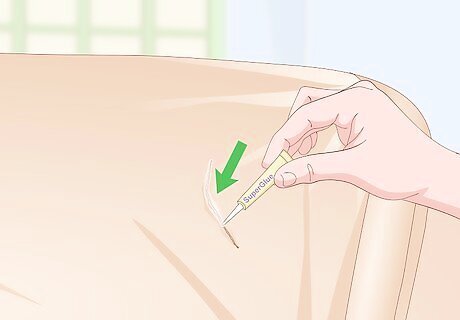
Line the patched area with a little super glue. Once your tear has been sealed with the leather glue, super glue can be used to fix the look of the leather and keep the fix strong. Apply a thin line of super glue over the tear in your couch, using a toothpick to push it into the crack. Dab over the glue with a paper towel immediately, removing the excess and texturing the glue. If you’re happy with the look of your couch once you’ve applied the sub-patch, you don’t need to continue working to cover it up. You will need to work very quickly with the super glue. Otherwise, it may dry and keep your toothpick or fibers from the paper towel stuck on the couch. Super glue can normally be removed with acetone, which is found in many nail polish removers.
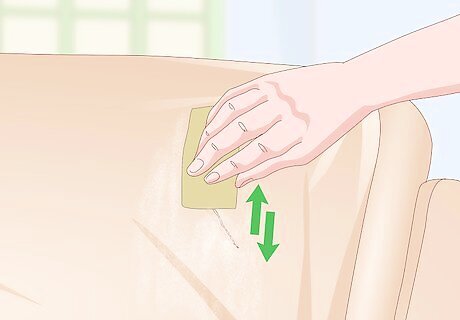
Sand in the direction of the tear with fine grit sandpaper. With the super glue still slightly wet, sand down the area around the tear. Use fine grit sandpaper, between 220 and 320-grit, to roughen the area and create dust that will help fill the gap in your couch. This will wear down the area around the tear slightly. You can easily fix it by refinishing the worn leather with a repair compound, a leather colorant, and some leather conditioner. If you’re not happy with the way the tear looks after the first application of super glue, you can repeat the process to smooth out the area further. Leave the glue to dry for a few minutes before adding another coat and sanding it down further. EXPERT TIP Mallika Sharma Mallika Sharma Certified Leather Care Technician Mallika Sharma is a Certified Leather Care Technician and the Founder of The Leather Laundry, a niche spa service for luxury leather gear in India. Mallika specializes in leather cleaning, coloring, repairing, and restoring for shoes, handbags, jackets, wallets, belts, and sofas. She holds a Master’s degree in Finance and Investment from the University of Edinburgh Business School. Mallika is a certified Professional Leather Care Technician and trained with the globally reputed leather care company, LTT in the United Kingdom. Mallika Sharma Mallika Sharma Certified Leather Care Technician Utilize invisible mending to sew tears in leather. Instead of using cover-up patches, try mending torn or damaged leather furniture, shoes, bags, and more. Sew ragged edges or tears back together using a sharp needle and strong, high-quality bonded nylon thread that matches the leather item’s original color as closely as possible. Use very small, tight stitching for a subtle and discreet fix that will be invisible to the naked eye.
Refinishing Worn Leather

Lay down newspaper to avoid making a mess. While the solutions used to repair and recolor your couch will do wonders for the look of the leather, they will easily stain your carpet or other nearby fabrics. Place a drop cloth down underneath the couch, or cover the surrounding area with old newspapers. It might also help to wear disposable gloves and older clothes when working with a leather colorant, just in case any gets on your hands or clothing.
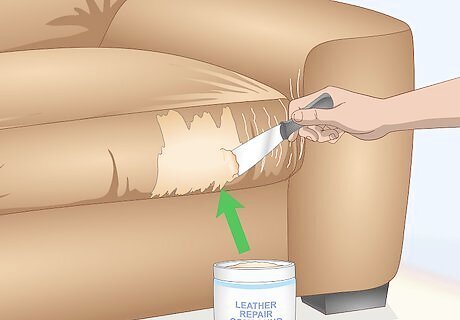
Apply a leather repair compound to the worn areas. Leather repair compounds, or leather binders, will seep into the leather and hold it together. Apply a small amount of a leather repair compound or binder to a clean sponge. Start in one corner of the couch and slowly cover the entire surface with the binder. Excess leather binder may build up in the seams of ridges of your couch. Use a clean paper towel to wipe away any excess as you apply it. Leather repair compounds or leather binders should be available online or from a leather specialist store.
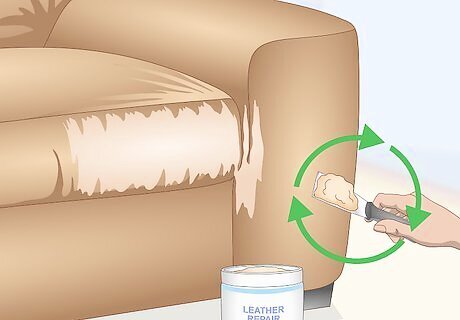
Let the repair compound dry and apply another coat. Leave your repair compound to air dry over the course of 30 minutes to an hour. Once it’s dry, use the same sponge to apply another coat or the binder. Repeat this process 3 to 5 times, or until you’re happy with the look of the couch. The number of coats you need to apply will vary based on how worn down the leather of your couch is. If there are only small cracks on the surface, 1 or 2 coats should suffice. For more damaged leather, 4 or 5 coats may be needed. You may be able to help some products dry quicker by using a heat gun or hair dryer. Keep the heat as low as you can to avoid damaging the leather.

Purchase a leather colorant that matches the color of your couch. Applying the wrong shade of leather colorant will make your couch look patchy and slightly off. Look online for a colorant matched as closely to the shade of your couch as possible. Alternately, you can take a leather sample to a leather repair specialist to have perfectly matched colorant mixed. It may be easier to look online when trying to find the perfect colorant, as you can more easily check the color of your couch from home. Taking a picture of your couch as a color reference can be helpful, but won’t necessarily reflect the exact color of the leather. Applying more coats of leather colorant will result in a darker color. Due to this, it’s better to buy a colorant that is lighter than the shade of your couch than one that is too dark.

Rub a thin coat of leather colorant into the couch. Apply a small amount of leather colorant to a clean sponge or foam applicator. Start in one corner of the couch and begin working across its surface, apply the colorant evenly. Focus on seams and creases that may be difficult to reach, so as to ensure you color the whole couch evenly. Avoid touching sections of the couch that you have applied leather colorant to. This may smudge the colorant and leave a noticeable mark. If there is only a small area that you need to recolor, focus only on that area. As long as the colorant matches the shade of the couch, you should be able to blend it in so that it’s unnoticeable.

Leave the surface to dry before applying more coats. Once the first coat of leather colorant has been applied, leave it for 30 minutes to an hour to dry fully. Use the same method as your first application to continue applying coats until you are happy with the way it looks. Alternately, you could use a spray gun or an airbrush to apply another layer of colorant. Work in very thin layers to smooth out the look of the leather, leaving time to dry in between each coat.
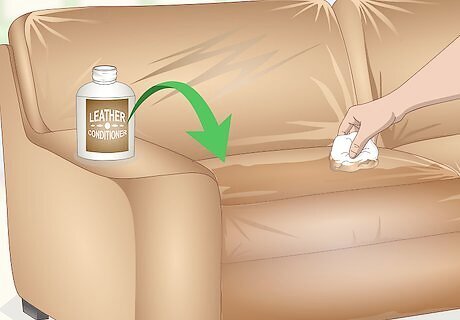
Use a leather conditioner to keep the couch soft and shiny. Once the leather has been properly colored and given plenty of time to dry, use a clean sponge to apply a thin layer of leather conditioner to the couch. Start in one corner and work in small, circular motions to buff and polish the couch with the conditioner. Wait for 2 to 3 hours to let the conditioner to dry fully. Leather conditioner should be available online, or at a leather specialty store. It may also be available as part of a leather repair kit.




















Comments
0 comment